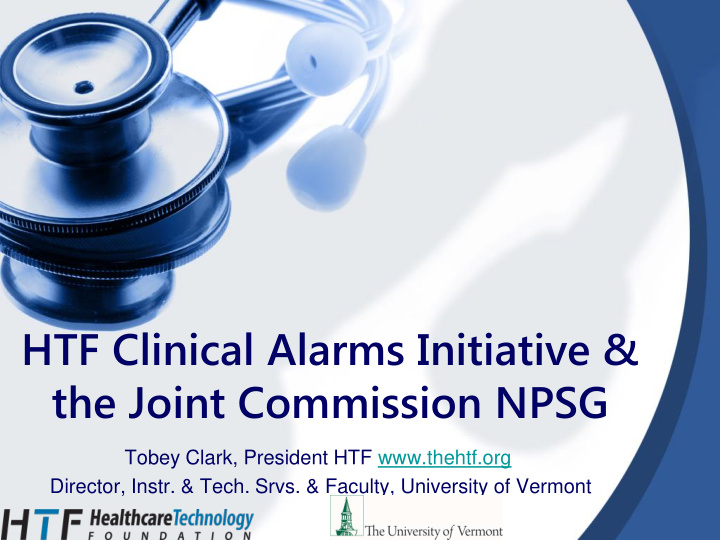



HTF Clinical Alarms Initiative & the Joint Commission NPSG Tobey Clark, President HTF www.thehtf.org Director, Instr. & Tech. Srvs. & Faculty, University of Vermont
Healthcare Technology Foundation Mission: • "Impr prove ove he healt lthc hcar are e deli liver very out utco comes mes by pro romoti oting ng the he devel velopme opment nt, appli lica cation tion and nd sup uppor ort t of safe e and nd effe fect ctive ive healt he lthc hcar are e tech chnol nologies ogies .“ Actions: • The promotion of excellence in clinical engineering leadership through research, education and certification • Funding of related research and programs, • Effective collaborations between medical device producers, regulators, users and clinical engineers, • The creation of safety-related education material that is useful to members of the pubic 2
Healthcare Technology Foundation Major initiatives: • Public Awareness and Education on Technology Safety • Managing Risks of Integrated Systems • Clinical Alarms Management and Integration • “To improve patient safety by identifying issues and opportunities for enhancements in clinical alarm design, operation, responses, communication, and appropriate actions to resolve alarm- related events.” HTF website: http://www.thehtf.org/ 3
Collaborative Organizations • FDA/MedSun – Food & Drug Administration • VA – Veterans Administration • AAMI – Association for the Advancement of Medical Instrumentation • AORN - Assoc. of periOperative Registered Nurses • AACN – Amer. Assoc. of Critical-care Nurses • AARC – American Association of Respiratory Care • ECRI – Emergency Care Research Institute • ACCE - American College of Clinical Engineering • META – Medical Equipment & Technology Assoc. • Industry – GE Medical, Philips Healthcare, Symantec, Masimo, and others • Individuals – Clinical engineers and nurses donating time and funds to HTF 4
Healthcare Technology Foundation Clinical Alarm Initiative Key Deliverable The HTF White Paper includes results from the 5 2006 US National Clinical Alarms Survey
Care e ma manage gement ment Design De gn Smart alarms Training Integration/remote Monitoring (rounds) Usability/human Use best practice factors guides Standards Institutional standards En Envir ironmenta nmental Clin Cl inic ical l eng ngin inee eeri ring ng Better design of Evaluate purchased items facilities for usability Monitoring (rounds) Test alarms in their environment Communication Software setup/testing Alarm integration to pager, cell phone, etc. 6
2011 US National Clinical Alarms Survey • Re-survey of the field • Sponsorship – AA AAMI, , AC ACCE CE, PH PHILI LIPS PS & HTF TF • Response: 4278 4278 responders sponders – 93 93% c % clinica ical l staf aff • Reported on the results at the AAMI Medical Device Alarms Summit
Survey Demographics: 4,278 healthcare staff responded to the survey
Survey Demographics: 2071 Respiratory Therapists & 1650 Nurses
Priorities
2015 HTF Clinical Alarms Task Force • Chair: Izabella Gieras, Huntington Hospital • Jennifer Ott, Thomas Bauld, Marge Funk, Yadin David, Karen Giuliano, Paul Coss, Marcia Wylie, Tony Easty, and Tobey Clark • Current/Recent Projects – Alarm Management Workshop • 2015 Association for the Advancement of Medical Instrumentation annual meeting – Three American Journal of Critical Care papers – Alarms and home health – Patient brochure • Alarms 101 11
Patient Education Brochures: Safe Use of Technology Focus on critical equipment
Alarms Brochure for Patients and Families • Introduction • Types of alarms • Why do these alarms sound? Is something wrong? • Impact of Clinical Alarms on Patients and Families • Role of the patients and visitors when clinical alarms sound • Healthcare Organizations involved with alarms – Review of publication by patient advocate 13
National Patient Safety Goal NPSG.06.01.01 Effective January 1, 2014, the Joint Commission is requiring hospitals to establish alarm management as an organization priority. Each organization must design a systematic and coordinated approach to this important safety issue. Additional requirements for policies and procedures and education will be required beginning in 2016.
TJC National Patient Safety Goal: Goal 6: Reduce the harm associated with clinical alarm systems
University of Vermont Medical Center (formerly Fletcher Allen Health Care)
University of Vermont Medical Center (formerly Fletcher Allen Health Care)
Incident Data Review 1,560 incident reports were analyzed. All data from US 314 reports directly involved the alarms
Incident Review All data from US
Incident Review All data from US
Alarm Type Review: 30 days data 50 bed Tele Unit Grand Total of All Alarms/Alerts: 172,970 Philips system only All data from US
Improvement: Online Alarms Education Online education since 2008 Orientation and ongoing education on high priority device alarms Sections Importance of alarms Device background & specific device guide Alarm audio and video for all device alarms Meaning and response / Evaluation http://its.uvm.edu/FAHC_Alarms/McClure5/IndexMCC5.html http://its.uvm.edu/FAHC_Alarms/Web%20Page/IndexNICU2.html
What Can Clinical Engineering Do? • Establish alarm system safety as hospital priority – Play a role in supporting leaders to make clinical alarms a priority • Identify the most important alarm signals to manage – Meet with clinical staff to prioritize – Provide risk-based input, failure data – Incident review – Educate on published best practices and guidelines • What alarm signals unnecessarily contribute to alarm noise and alarm fatigue • Alarms rounds – use your senses • Measure alarm frequency by type • Support the process to revise default alarm settings – Non actionable, unreliable, procedural – Individualized by patient • Training development and delivery
Resources • Healthcare Technology Foundation (HTF) – Clinical Alarms Management and Integration • http://thehtf.org/clinical.asp • Association for the Advancement of Medical Instrumentation (AAMI) – Healthcare Technology Safety Institute – Clinical Alarms • http://www.aami.org/htsi/alarms/index.html • http://www.aami.org/htsi/safety_innovation.html • American Association of Critical-care Nurses (AACN) – Strategies for Managing Alarm Fatigue • http://www.aacn.org/dm/practice/actionpakdetail.aspx?itemid=28337&learn= true&menu=practice&utm_medium=print&utm_source=various&utm_camp aign=actionpak
Tobey.clark@uvm.edu
Recommend
More recommend